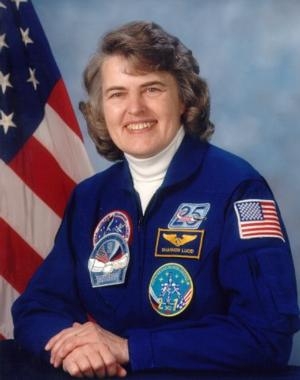Wed, Feb 01, 2012
Veteran Of Five Spaceflights Logged 223 Days In Space
Shannon Lucid, a member of NASA's first astronaut class to
include women, has retired after more than three decades of service
to the agency. A veteran of five spaceflights, Lucid logged more
than 223 days in space, and from August 1991 to June 2007, held the
record for the most days in orbit by any woman in the world. Lucid
is the only American woman to serve aboard the Russian Mir space
station. She lived and worked there for more than 188 days, the
longest stay of any American on that vehicle. Her time on Mir also
set the single flight endurance record by a woman until Suni
Williams broke it in 2006.
Shannon Lucid

"Shannon is an extraordinary woman and scientist. She paved the
way for so many of us," said Peggy Whitson, chief of NASA's
Astronaut Office at the Johnson Space Center in Houston. "She was a
model astronaut for long-duration missions, and whether she was
flying hundreds of miles up in space or serving as Capcom [capsule
communicator] during the overnight hours for our space shuttle and
space station crews, she always brought a smile to our faces. Like
so many others, I always will look up to her."
Lucid, who holds a doctorate in biochemistry, was selected by
NASA in 1978. She joined five other women as the agency's first
female astronauts. Her first three shuttle missions deployed
satellites. STS-51G in 1985 deployed and retrieved the SPARTAN
satellite; STS-34 in 1989 deployed the Galileo spacecraft to
explore Jupiter; and STS-43 in 1991 deployed the fifth Tracking and
Data Relay Satellite (TDRS-E). Her fourth shuttle mission, STS-58
in 1993, focused on medical experiments and engineering tests.
Lucid traveled aboard Atlantis on STS-76 in March 1996 to the
Russian Mir space station. She performed numerous life science and
physical science experiments during the course of her stay. She
returned from the station aboard Atlantis on STS-79 in September
1996.
In 2002, Lucid served as NASA's chief scientist at the agency's
headquarters in Washington. She returned to Johnson in the fall
of
2003 and resumed technical assignments in the Astronaut Office. She
served as a Capcom in the Mission Control Center for numerous space
shuttle and space station crews, representing the flight crew
office and providing a friendly voice for dozens of friends and
colleagues in space.
More News
Light Gun A handheld directional light signaling device which emits a brilliant narrow beam of white, green, or red light as selected by the tower controller. The color and type of>[...]
"The journey to this achievement started nearly a decade ago when a freshly commissioned Gentry, driven by a fascination with new technologies and a desire to contribute significan>[...]
Aero Linx: JAARS, Inc. For decades now, we’ve landed planes on narrow rivers and towering mountains. We’ve outfitted boats and vehicles to reach villages that rarely se>[...]
"Our driven and innovative team of military and civilian Airmen delivers combat power daily, ensuring our nation is ready today and tomorrow." Source: General Duke Richardson, AFMC>[...]
Aircraft Conflict Predicted conflict, within EDST of two aircraft, or between aircraft and airspace. A Red alert is used for conflicts when the predicted minimum separation is 5 na>[...]
 ANN's Daily Aero-Term (04.20.24): Light Gun
ANN's Daily Aero-Term (04.20.24): Light Gun Aero-News: Quote of the Day (04.20.24)
Aero-News: Quote of the Day (04.20.24) ANN's Daily Aero-Linx (04.21.24)
ANN's Daily Aero-Linx (04.21.24) Aero-News: Quote of the Day (04.21.24)
Aero-News: Quote of the Day (04.21.24) ANN's Daily Aero-Term (04.21.24): Aircraft Conflict
ANN's Daily Aero-Term (04.21.24): Aircraft Conflict



